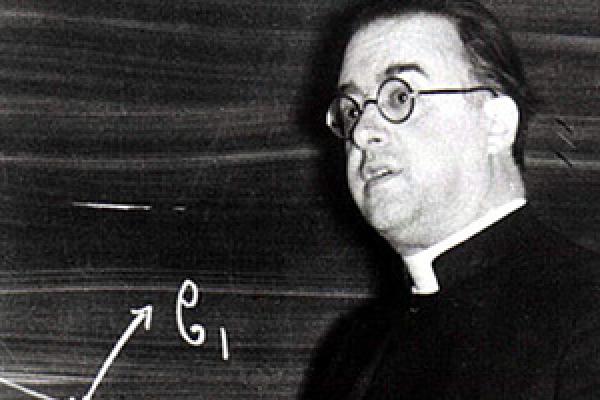It All Goes Back to the Big Bang

Chris Orban, theoretical physicist at Ohio State’s Marion campus, studies laboratory and astrophysical plasmas in cosmological simulations. The assistant professor of physics leads the 2016 Battelle Engineering, Technology and Human Affairs (BETHA) grant-funded project, “The Revolution in Cosmology: Fr. Georges Lemaitre’s Hidden God,” which focuses on the life and work of cosmologist and Catholic priest Georges Lemaître, who helped found the Big Bang theory.
Orban loves to explain modern cosmology’s beginnings to today’s audiences. That period — early 20th-century cosmology — posed great questions:
- Is the universe infinitely old?
- Is the universe infinitely large?
- Will the universe ever stop expanding and start contracting?
“While these questions are no longer at the center of cosmology debate, in most people’s minds (certainly, mine, when I was a kid) these are the questions that are the most fun to think about,” said Orban. “It’s interesting to go back to when Einstein and others were wrestling with these issues."
What fascinates you about Lemaître and the origins of the Big Bang theory?
The story that got me hooked took place in 1927: Georges Lemaître, who had just completed his PhD, approached Einstein at a scientific conference, pointing out his theory of relativity is compatible with the notion of an expanding universe, which may have begun in a hot, dense state.
If “hot, dense state” sounds familiar, it should; it is what we now call the Big Bang. Back then, Lemaître referred to it as The Primeval Atom. It would not acquire the title "Big Bang" until much later, as a derisive term coined by the outspoken Cambridge astronomer Fred Hoyle.
Einstein dismissed Lemaître's thoughts on the possibility of an expanding universe. It was not until Hubble’s observations were published that he would change his mind.
This episode is a great illustration of the scientific process and reminds us that even Einstein sometimes got it wrong. That Georges Lemaître was an ordained priest in the Catholic Church just makes it more interesting.
How is your BETHA project highlighting Lemaitre and his work?
The BETHA project, a collaboration among physicists, astronomers and philosophers, offers coursework on Lemaître. It involves a student-led STEAM project on the expansion of the universe with public lectures on Lemaître’s.
What else do you have on tap to make this era and Lemaitre come alive?
I’m working with Ohio State’s planetarium director Wayne Schlingman and others to create a show using footage from a little-known episode about Lemaître from Stephen Hawking’s Universe, which the BBC gave us permission to use.
We hope to finish it by the end of 2017 and present a one-night-only showing at COSI’s planetarium.
I’m also partnering with Astronomy on Tap to do some fun events related to the project. On March 2, I’ll be talking about Einstein and Cosmology at Strongwatern from 6-9 p.m. Join me!
Think the #BigBang theory is outdated? To @OSUMarion physicist Chris Orban, it’s more relevant than ever. #ASCDaily
